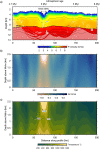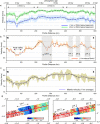Evolution of the Crustal and Upper Mantle Seismic Structure From 0-27 Ma in the Equatorial Atlantic Ocean at 2° 43'S
- PMID: 35865731
- PMCID: PMC9285972
- DOI: 10.1029/2020JB021390
Evolution of the Crustal and Upper Mantle Seismic Structure From 0-27 Ma in the Equatorial Atlantic Ocean at 2° 43'S
Abstract
We present seismic tomographic results from a unique seismic refraction and wide-angle survey along a 600 km long flow-line corridor of oceanic lithosphere ranging in age from 0 to 27 Ma in the equatorial Atlantic Ocean at 2° 43'S. The velocities in the crust near the ridge axis rapidly increase in the first 6 Myr and then change gradually with age. The upper crust (Layer 2) thickness varies between 2 and 2.4 km with an average thickness of 2.2 km and the crustal thickness varies from 5.6 to 6 km along the profile with an average crustal thickness of 5.8 km. At some locations, we observe negative velocity anomalies (∼-0.3 km/s) in the lower crust which could be either due to chemical heterogeneity in gabbroic rocks and/or the effects of fault related deformation zones leading to an increase in porosities up to 1.6% depending on the pore/crack geometry. The existence of a low velocity anomaly beneath the ridge axis suggests the presence of partial melt (∼1.3%) in the lower crust. Upper mantle velocities also remain low (∼7.8 km/s) from ridge axis up to 5 Ma, indicating a high temperature regime associated with mantle melting zone underneath. These results suggest that the evolution of the crust and uppermost mantle at this location occur in the first 10 Ma of its formation and then remains unchanged. Most of the structures in the older crust and upper mantle are fossilized structures and could provide information about past processes at ocean spreading centers.
Keywords: evolution of lithosphere; mid‐ocean ridges; tomography.
© 2021. The Authors.
Figures











References
-
- Alt, J. C. , Laverne, C. , Coggon, R. M. , Teagle, D. A. H. , Banerjee, N. R. , Morgan, S. , et al. (2010). Subsurface structure of a submarine hydrothermal system in ocean crust formed at the East Pacific Rise, ODP/IODP Site 1256. Geochemistry, Geophysics, Geosystems, 11(10), Q10010. 10.1029/2010GC003144 - DOI
-
- Anonymous (1972). Penrose field conference on ophiolites. Geotimes, 17(12), 24–25.
-
- Audhkhasi, P. , & Singh, S. C. (2019). Seismic structure of the upper crust from 0–75 Ma in the Equatorial Atlantic Ocean on the African Plate using ultralong offset seismic data. Geochemistry, Geophysics, Geosystems, 20(12), 6140–6162. 10.1029/2019GC008577 - DOI
-
- Bazin, S. , Harding, A. J. , Kent, G. M. , Orcutt, J. A. , Tong, C. H. , Pye, J. W. , et al. (2001). Three‐dimensional shallow crustal emplacement at the 9°03′N overlapping spreading center on the East Pacific Rise: Correlations between magnetization and tomographic images. Journal of Geophysical Research, 106(B8), 16101–16117. 10.1029/2001jb000371 - DOI
-
- Bell, R. E. , & Buck, W. R. (1992). Crustal control of ridge segmentation inferred from observations of the Reykjanes Ridge. Nature, 357(6379), 583–586. 10.1038/357583a0 - DOI
LinkOut - more resources
Full Text Sources
Miscellaneous
